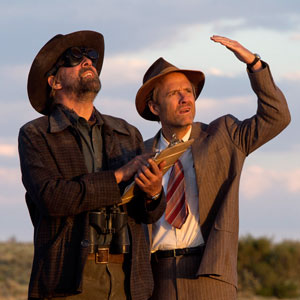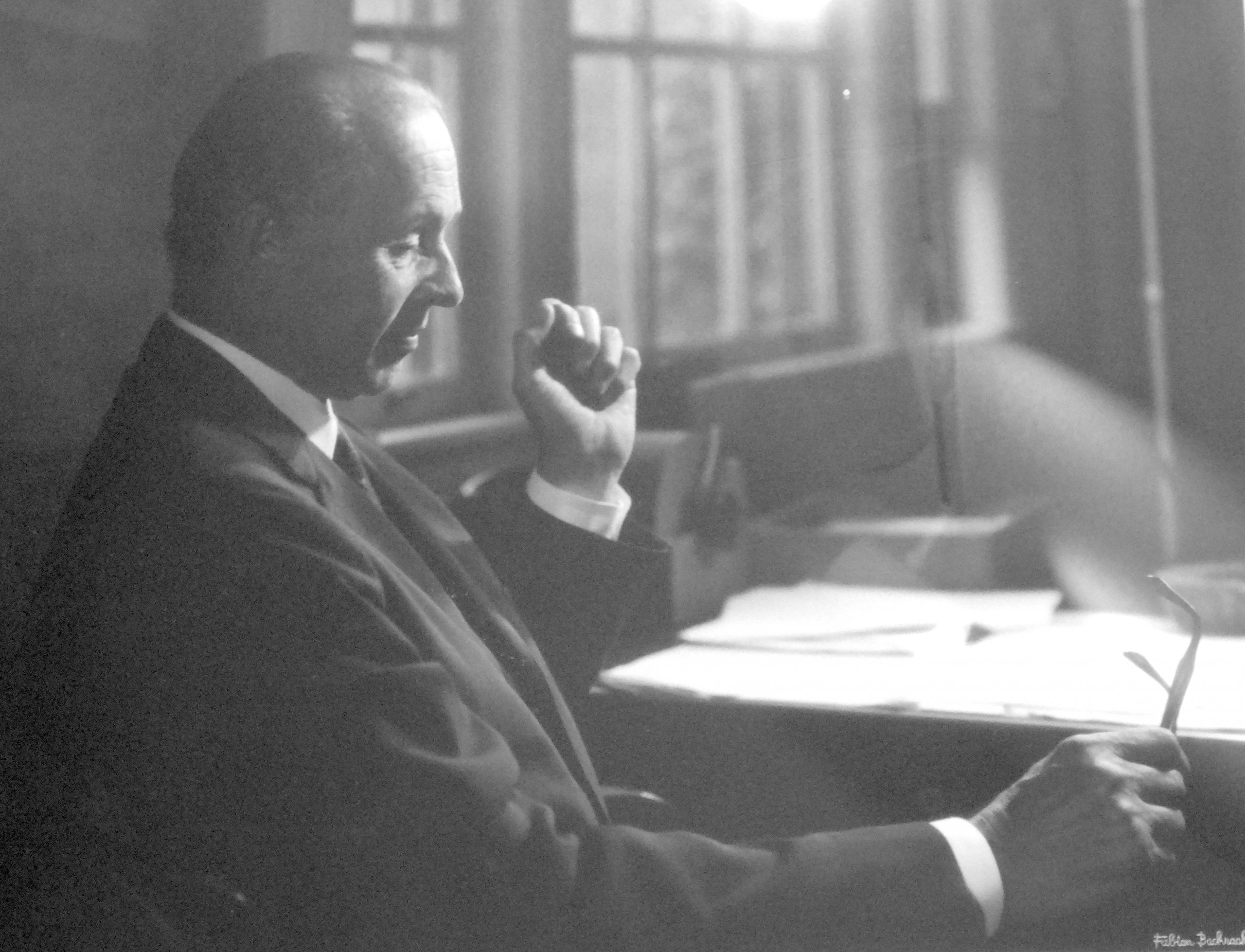One of the most difficult problems that physicists faced during the Manhattan Project was figuring out a way to make an implosion-type atomic weapon. The complexity of the problem required the input of dozens of scientists from different disciplines and areas of expertise.
In order to create a perfectly symmetrical shockwave that would “implode” inwards to compress a solid plutonium sphere, Los Alamos director J. Robert Oppenheimer enlisted the help of the nation’s top civilian explosives expert: George Kistiakowsky.
Born in Kiev, Ukraine in 1900, Kistiakowsky had fought in the anti-communist White Army’s infantry and tank corps during the Russian Revolution before fleeing to Germany in 1921. He received his Ph.D. in Chemistry from the University of Berlin in 1925 and immigrated to the United States a year later, joining the faculty at Princeton as an International Education Board Fellow.
In 1930, Kistiakowsky accepted a position as Professor of Chemistry at Harvard University. There, he became increasingly involved in consulting for the government and industry. In 1933, Kistiakowsky became an American citizen.
Joining the War Effort
-768x1024.jpg) When the war broke out in Europe in 1939, Kistiakowsky was determined to join the fight. “I grew up in a family in which the question of civil rights, human freedom, was a very important one,” says Kistiakowsky, whose 1982 interview with historian and Pulitzer Prize-winning author Richard Rhodes can now be heard on Voices of the Manhattan Project. “I went to war work because I had a very intense rejection of Hitler and fascism.”
When the war broke out in Europe in 1939, Kistiakowsky was determined to join the fight. “I grew up in a family in which the question of civil rights, human freedom, was a very important one,” says Kistiakowsky, whose 1982 interview with historian and Pulitzer Prize-winning author Richard Rhodes can now be heard on Voices of the Manhattan Project. “I went to war work because I had a very intense rejection of Hitler and fascism.”
In 1940, Kistiakowsky was appointed head of the Explosives Division for the National Defense Research Committee. There, he applied his expertise in thermodynamics and chemical kinetics to explosives research for the military. Kistiakowsky quickly was recognized as one of the nation’s leading experts in high explosives.
As physicists at Los Alamos struggled with implosion, Oppenheimer reached out to Kistiakowsky for help. “They needed me over there because I was supposed to be the number one civilian explosives expert, with these new-fangled ideas about explosives position instruments,” concedes the chemist.
At first, Kistiakowsky was hesitant. “I did not want to go there [Los Alamos], I had other plans for myself,” he explains. Kistiakowsky wanted to be on the front lines. “He did not want to be buried in an organization,” recalls Vera Kistiakowsky, George’s daughter. “He was thinking of maybe joining one of the teams that went to Europe to look at what the Germans had done [in the Alsos Mission], following the retreating German Army.”
In 1944, Oppenheimer solicited the help of the President of Harvard and Manhattan Project administrator James B. Conant to persuade Kistiakowsky to join the project. “Oppenheimer got Conant to lean on George,” remembers Vera, “And so George went to Los Alamos.”
But before Kistiakowsky agreed to join, he had several conditions. “In my case, there were three exceptions made,” he recalls. “[The first was that] my salary was fixed properly—that is, commensurate to a Harvard salary and not the civil service salary which I was getting at the time which was much lower.” The second condition was that he be given his own house on Bathtub Row, “because as a chemist, I would have been given very low quality housing.”
The third condition probably stretched General Leslie Groves’s patience. “The third condition,” says Kistiakowsky, “was that my daughter could spend the summers with me, and yet go to college, which was completely an unusual arrangement. She was the only teenager who was allowed to go in and out that way.” Vera, who graduated high school in the spring of 1944, would be attending Mount Holyoke College that coming fall.
From Cambridge to Los Alamos
In June, George and Vera packed up their belongings and made their way to Los Alamos. The two moved into a little stone house on Bathtub Row. “It had originally been the power house for the Ranch School that had occupied the mesa,” says Vera, “but it was modified to become a very comfortable little house.” Vera slept in the house’s only bedroom and her father slept on a pullout couch in the living room.
One of the first things that Kistiakowsky did when he arrived was to purchase two horses so that he and Vera could go riding together. He bought one horse, Crisis, from Oppenheimer. Vera received Guest, a half-thoroughbred Bay Gelding. The two enjoyed riding together in the evenings after supper.
With her father working long hours at the laboratory, Vera was free to roam the Los Alamos countryside on horseback. “I had certain chores that I was supposed to do, but otherwise I was completely on my own,” she remembers. “For the first time in my life, I did not have somebody who was telling me what to do—I could go riding by myself.”
Solving Implosion
 After hundreds of experiments and months of testing, Kistiakowsky’s Explosives Division finally produced a promising configuration for implosion. The key was a series of explosives lenses that would invert the resulting shockwave to compress a solid sphere of plutonium. “Each initiation point would be centered on a lens, which would convert a diversion beam of an explosion wave into a convergent beam, very much like an optical lens converts divergent light into a convergent light,” explains Kistiakowsky. By varying the burn rates of different explosive mixtures, his team could create a perfectly symmetrical shockwave.
After hundreds of experiments and months of testing, Kistiakowsky’s Explosives Division finally produced a promising configuration for implosion. The key was a series of explosives lenses that would invert the resulting shockwave to compress a solid sphere of plutonium. “Each initiation point would be centered on a lens, which would convert a diversion beam of an explosion wave into a convergent beam, very much like an optical lens converts divergent light into a convergent light,” explains Kistiakowsky. By varying the burn rates of different explosive mixtures, his team could create a perfectly symmetrical shockwave.
With the first test of the implosion bomb looming in the summer of 1945, many of the physicists were doubtful that the design would succeed. “Everybody except my division, the X [Explosives] Division, were very skeptical as to whether the lenses would work properly,” says Kistiakowsky. “Thirty-eight hours before the actual Trinity test, there was a test which indicated that they didn’t work, which created enormous emotional outbursts about mine and everybody else’s work.”
Kistiakowsky remained confident that his design would work. “When I bet in that pool that was running before the Alamogordo test,” recalls Kistiakowsky, “I bet Oppenheimer about six or seven hundred dollars against ten dollar bills that the explosive part would work and there would be some nuclear reaction.”
After weeks of frantic activity on the hill, Vera’s father suddenly disappeared. “One day, he told me that he was going to be gone for a few days and gave me money so that I could buy food and disappeared,” she remembers. “That was all I knew about it until he came back the following day, and there was great excitement at Los Alamos—but muted—and still I was told nothing.” Kistiakowsky had won the bet: the Trinity test had succeeded.
When news of the Hiroshima bombing broke three weeks later on August 6, 1945, Vera finally learned what her father had been working on. “There was not a party after Hiroshima,” says Vera. “They did not party; the people who knew about the weapon just could not party about it.”
V-J Day on the Hill
When news of the Japanese surrender reached Los Alamos two weeks later, the mood was quite different. Kistiakowsky celebrated the only way he knew how. “After V-J Day I got fairly soused at a party given by Robert Bacher,” he recalls. “Those around me egged me on and so I went to the explosive stores and got out twenty-one fifty pound boxes of TNT. With the help of a young man—since I was rather far gone—fired them off in a field and came back. The bastards told me I fired twenty-two.”
But the fun didn’t stop there. “I went to sleep in my little house, which was across the street from Bacher’s house,” remembers Kistiakowsky, “And they created a fantastic pile of empty bottles—beer, whiskey, tequila—in front of my only door, so I was really stuck for a while.”
Kistiakowsky exacted his revenge a few nights later. “I got even because I arranged with my trusty friends from my division to bring some exceedingly heavy objects and blocked the doors of the man who I knew was the initiator of that last trick,” he admits. “Those things required a crew of workmen to remove from these doors.”
From Scientist to Stardom
 At the end of the summer, George stayed at Los Alamos and Vera returned to Massachusetts for her second year at Mount Holyoke. She excelled in chemistry and math, just like her father. “I thought very highly of my father,” says Vera. “He told me very seriously that I should find something to do that would support me and not rely on getting married and finding someone who would support me.”
At the end of the summer, George stayed at Los Alamos and Vera returned to Massachusetts for her second year at Mount Holyoke. She excelled in chemistry and math, just like her father. “I thought very highly of my father,” says Vera. “He told me very seriously that I should find something to do that would support me and not rely on getting married and finding someone who would support me.”
Shortly after the war, George Kistiakowsky returned to Harvard to teach Chemistry and was named to Eisenhower’s Presidential Science Advisory Committee. Later on, Kistiakowsky severed his connections with the government in protest against the US involvement in the Vietnam War and became an active member of the antiwar organization the Council for a Livable World.
Vera graduated from Mount Holyoke and attended the University of California-Berkeley, where she received her Ph.D. in nuclear chemistry under renowned chemist and Manhattan Project veteran Glenn Seaborg. Vera joined the faculty at MIT in 1963. In the late 1960s, she began advocating for the advancement of women in science. Like her father, she became concerned with issues of international security and weapons policy. She has since lectured and written on these issues and later served on the board for the Center for Arms Control and Non-Proliferation.
George Kistiakowsky’s unique role during the Manhattan Project inspired the creators of the popular Manh(a)ttan (2014) television series on WGN America to feature a character, Lazar, as the head of the Explosives Division (though clearly not someone who is likely to become President Eisenhower’s Science Advisor). Months before his death in 1982, Kistiakowsky predicted he would be a star: “They will probably make a TV story on me, because they think I am extraordinarily photogenic and the way I handle things was just absolutely superb and all that crap.”





